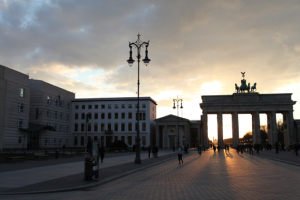In honor of the 30thanniversary of the fall of the Berlin Wall, the American Studies Blog will remember this spectacular event in history through the eyes of people from around the world during the next few weeks.

When Everything Changed
“Your friend Jörg called. There’s something going on at the border.” “What border, the Hungarian?” I was taking off my coat thinking of the pictures I’d seen of Hungarian border patrols cutting the wire fence and letting East Germans through only a few months before. “He said you should turn on the TV.” And so I did, and there they were, the celebrating Berliners climbing on top of the wall, welcoming stunned East Berliners, joined in delirious joy for the first time in four decades. And here I was, almost 7,000 kilometers away in Ann Arbor, Michigan, where I’d been teaching for the last four years.
Only the summer before, my American friend and I had visited Berlin, the divided city, a first for both of us. It had been an emotional visit for me. When passing Weimar, thinking of the rich history of the town and shuddering upon seeing the tower of the KZ Buchenwald in the distance, I had been asking myself how it was possible to divide a country and a culture. I regretted that we couldn’t simply take a little detour, leave the transit route, and explore the part of Germany that had been closed off to casual visitors. Unfortunately, we only had permission to transit to West Berlin, and so we drove on. We explored the eastern part of town, crossed via Friedrichstraße under the intimidating stares of the young border police officers, walked through what’s today the fashionable “Mitte” district, looked in amazement at the ruins of the burnt-out synagogue on Oranienburgerstraße, and had Rotkäppchensekt at a local pub. Speaking English, we stuck out and were clearly identified as westerners. Standing in front of the impressive main building of Humboldt University on Unter den Linden, I asked myself: “Wouldn’t it be nice to teach here one day?” We hiked along the wall, on the western side, of course, which cut off neighborhoods, dividing friends and families. For me, the wall was a foreign, frightening object that meant to be there for at least the next hundred years, as Erich Honecker, General Secretary of the Socialist Unity Party of Germany (SED), had declared only in January 1989.
Sitting on my bed and staring at the little TV, I longed to be where total strangers embraced in disbelief, leaving behind all that had been dividing them for one long, unforeseen, incredibly exciting night. Crying, silently, I chastised myself for being emotional about what I was witnessing: a nation coming together, flags being waved, history in the making. For my generation, patriotism was a dangerous thing, something that could be exploited, manipulated, and twisted. I had always identified as European first, then as German.
Eager to discuss what had just happened, I took the bus for the short ride to campus the next morning. But nobody was talking. Business as usual, people reading the paper or staring out the window, avoiding eye contact. My colleagues in the office didn’t say anything either. They met with students, prepared for classes. How could they not react to the historical earthquake that had just happened? 30 years later, I learned from a friend that he experienced ‘the day after’ in exactly the same way – but in Mainz, not in Ann Arbor. Here and there, it took people a while to adjust to the new realities and sort out how they felt about it all and what it would mean. But for me, everything had changed.
A year later, I went back to Germany. In 1998, I moved to Berlin as part of the Hauptstadtumzug, the move of government offices and affiliated organizations to the new capital. I settled for a short time in the Mitte district. And shortly after, I started teaching a regular class at Humboldt University on U.S. public diplomacy during the Cold War. Who would have thought?
I’m still amazed at what happened to this city and this country. I always know what part of town I’m in, east or west, when moving through the city unhindered by a wall and a death strip. I love Pariser Platz, the old and new location of the American Embassy, early in the morning before the daily circus starts when the bike riders cycle through Brandenburg Gate on their way to work as if it were the most normal thing to do. It’s peaceful then, sometimes a bit unreal, dreamlike. I watch the square from a small conference room, the Bush Room, where photos of that historic night on November 9, 1989, the negotiations regarding unification, and the political players decorate the wall. And I remind my Humboldt students that we wouldn’t be in this particular building, this seminar room with windows facing the S‑Bahn tracks, and the famous east Berlin TV tower thirty-some years ago. “You wouldn’t be taking classes with Erasmus students from Spain, France, or Poland,” I tell them. And they ask: “What was it like when the wall fell?”
“Well, I was almost 7,000 kilometers away, but then everything changed.”
22,642 Total Views, 8 Views Today






